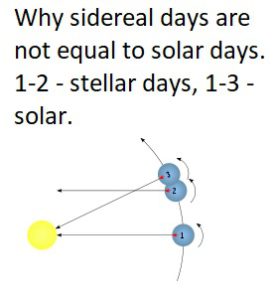What is the rotation of the Earth?
We explain what is the rotation of the Earth speed and what are its consequences. The speed it reaches and the translation of the Earth.
What is the rotation of the Earth?
The rotation of the Earth is the movement that the planet makes when turning on its own axis , that is, on itself. This axis consists of an imaginary line that crosses the geographical poles and that has an inclination of 24 ° with respect to the Earth’s orbit.
The earth rotation movement takes 24 hours to make the complete turn, at a speed of 1,700 kilometers per hour if measured in the equator. We do not feel the movement because it is done constantly and because we move at the same speed with the Earth, that is, we are part of the same system of earth movement. If the speed of the movement were not constant, we would feel it due to inertia.
Consequences of rotation movement

The Earth’s rotation movement generates consequences at the geographical, climatic, terrestrial and physical levels. The main ones are:
- The succession of day and night. The Sun illuminates only one half of the planet, which determines that it is daytime, while the opposite face remains dark generating night. As the planet rotates on its own axis, the face that remained dark begins to receive the light and the other half darkens.
- Time differences. The time zone system consists of a division of the day into hours for the entire planet, and has as its starting point or reference, the zero meridian or Greenwich meridian . That is why it dawns and dusk in the eastern hemisphere rather than in the western hemisphere.
- The variation of temperature. The succession of day and night means that, during the day, the illuminated face of the planet receives more solar radiation. That energy accumulates and generates a temperature increase. During the night, that face does not receive solar radiation and the temperature decreases.
- The shape of the Earth. If the Earth were still, its sphere shape could be appreciated, that is, round. As the rotational movement is constant, a centrifugal force is generated responsible for flattening the zone of the poles or the axis of the Earth and widening the area of the equator. Because of the rotation movement, the planet is shaped like an ellipse or geoid.
- The Cardinal points. As the planet performs the movement of rotation from the west to the east and the Sun is at a fixed point, from Earth it is seen peeking from the east at dawn and is hidden by the west at sunset. This data is useful for locating the cardinal points in case of not having a compass.
- The magnetic field of the Earth. The rotation movement generates a magnetic field or energy that protects the Earth from solar radiation through the atmosphere (layer composed of gases and surrounding the Earth). While the planet and living things need the light and heat of the Sun, some of its rays are harmful. This magnetic field causes a stream of particles in the atmosphere that blocks them and does not allow them to reach the earth’s surface.
Period and speed of rotation of the earth
The speed of the earth’s rotation varies depending on the area of the planet where it is calculated. From the equator, that is, the imaginary line that marks the maximum circumference of the Earth, the route is 1,700 km per hour.
As you move away from the equator towards the poles, the speed is slower . For example, at the point located at 45 ° north latitude, the rotation speed is 1,000 km per hour. Over the poles, where the imaginary axis passes, the speed is zero or 0 km per hour.

- The earth rotates from west to east.
- The axis of rotation of the Earth is tilted at an angle of 66 ° 34 ′ to the plane of the Earth’s orbit (see Tilt of the axis of rotation ).
- The Earth makes a full revolution (in the inertial reference system ) in a sidereal day (86164.090530833 s ≈ 23 hours 56 minutes 4 seconds).
- The angular velocity of the Earth’s rotation
 s −1 .
s −1 . - The linear speed of the Earth’s rotation (at the equator) is 465.1013 m / s (1674.365 km / h). The linear speed of rotation at 60 ° latitude is half that at the equator.
- Linear speed of rotation of the Earth at an arbitrary latitude and height above sea level:
Where = 6378.1 km – equatorial radius, = 6356.8 km – polar radius.
- An airplane flying at this speed from east to west (at an altitude of 12 km: 936 km / h at the latitude of Moscow , 837 km / h at the latitude of St. Petersburg ) will rest in the inertial frame of reference.
- The superposition of the Earth’s rotation around an axis with a period of one sidereal day and around the Sun with a period of one year leads to an inequality of solar and sidereal days: the length of an average solar day is exactly 24 hours, which is 3 minutes 56 seconds longer than a sidereal day.
Earth translation

The movement of translation occurs between two celestial bodies when the first one turns around its orbit around the second. In the case of the Earth it is to turn around the sun . Our planet takes 365 days and 6 hours to complete that translation journey.
When the movement of the Earth’s movement interacts with the movement of rotation, phenomena such as the succession of the seasons of the year, and the duration of day and night occur.










